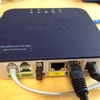 OUT OF THE BLUE — A BOLT OF BLUE
OUT OF THE BLUE — A BOLT OF BLUERather than working on the Dialogic boards during work hours, I decided to come in on a Sunday, when incoming phone traffic would be minimal. Then, I would be free to pull out both Dialogic boards and replace them with the new boards Artisoft had sent me.
While pulling out one of the faulty boards, I saw a blue arc of electric current, half an inch long, pass between the two boards! Since the boards were so close together, a soldering pin on one of the boards must have touched the other board. “Well,” I thought to myself, “if it wasn’t broken before, it’s definitely broken now!” I had that odd, giddy sensation you sometimes get when you think you may have destroyed something expensive.
Dialogic explained they had some issues with the BlackBox ring voltage generators and that they solved the issue, but not before I nearly fried myself.
Well, I bring this all up because I just came across a great article from the Michigan Telephone, VoIP, and Broadband Blog...
The article discusses ring voltage, which brought back memories of my 1999 article. Specifically, the article talks about VoIP, ringer equivalence number (REN), and how VoIP ATAs limit their REN, resulting in analog phones not ringing if you exceed the REN limit. I know this full well, because I've experienced ringing issues on my VoIP ATAs when I overload them.
Most telcos provide enough current to ring five telephones, also known as the standard 5 REN, however VoIP analog telephony adaptors (ATAs) often limit it to just 3 REN. If you connect more than 3 phone devices your phones ringing will be very weak or it won't ring at all.
Back when I had Vonage, I disconnected the telco wiring outside the house and then connected my Cisco ATA-186 ATA to my home wiring. This powered the entire house's wall jacks with analog dialtone. Fortunately, Cisco wasn't cheap and this ATA supports 5 REN up to 200 feet. However, I'm constantly testing VoIP equipment and analog devices, so I did eventually break the 'ringing' after hooking up like 12 analog devices.
Thus, if you use VoIP ATAs you either have to disconnect some phones, shut off some of the ringers in the phones, or figure out a way to boost the ring current. That's where the Michigan Telephone, VoIP, and Broadband Blog article comes in. The article reviews Mike Sandman Enterprises Ring Voltage Booster II™ - the successor to the original Ring Voltage Booster™. According to the article, this device will solve those ringing problem ills. Great! With this device now I can have 10 phones ringing downstairs in my home lab, and 3 phones ringing upstairs. That is if my wife doesn't kill me.












